If counter-attacking is the second name of German football, the DFB Pokal is a tournament in which teams turn it up a notch. Werder Bremen and Bayern Munich are two teams that always have surprises in store for each other. This season, these two have produced tightly contested fixtures with both ending up with only a single goal difference across their previous three encounters.
This game unfolded quietly at the beginning but the drama picked up steadily as the minutes progressed leaving the climax to the end. The semi-final was fought tooth and nail with crossbars and posts required to step in for both, stopping and assisting goals. In this tactical analysis we examine how the Bavarians put an end to Werder Bremen’s dream run in the tournament.
Lineups
Nico Kovač has managed to restore Bayern to winning ways since the turn of the New Year utilising a 4-2-3-1. The double pivot system utilises Javi Martínez in a more defensive central midfield role while Thiago Alcântara has more license to roam around and receive the ball behind lines of pressure.
Having experimented heavily as an attacking midfielder during the Guardiola days, Thomas Müller is chosen to play a very specific number 10 role. Kingsley Coman and Serge Gnabry started the semi-final looking to offer pace out wide.
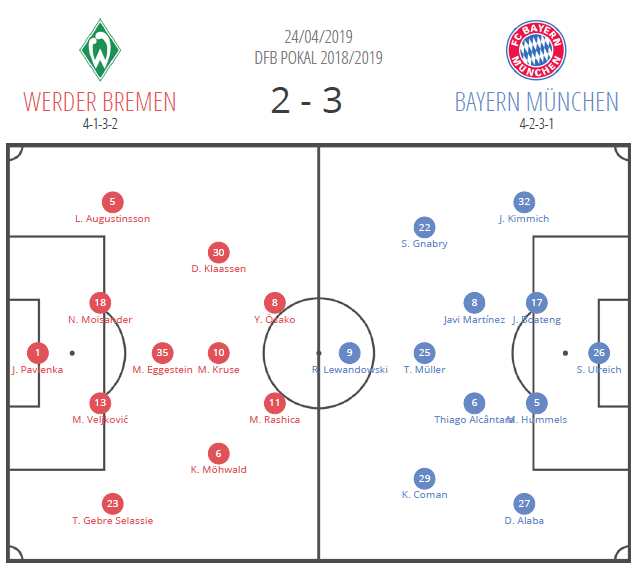
Florian Kohfeldt has been managing a rather successful season with Werder Bremen with his 4-3-1-2. The attacking pair always involves the in-form Milot Rashica up front while the veteran Max Kruse plays a deeper attacking role as a number 10. The central midfield comprised of ex-Ajax product Davy Klaassen, Kevin Möhwald and the home-bred Maximilian Eggestein. The Japanese Yuya Osako was chosen to partner Rashica up top looking to combine quickly on the counter-attack and create opportunities for Bremen.
Cautious beginnings
As anticipated, Bayern began to have most of the possession stretching play wide. Bremen held a tight row of two with their defenders and midfielders while the front three constantly pressed Bayern to force a turnover of possession.
The use of three central midfielders helped Bayern press the wide players effectively and give very little room for Thiago and Müller to work. Their attacking strategy was to deploy plenty of vertical passing during build-up phases and utilise the quick pace of Rashica and Osako to attack the space left by Bayern’s high full-backs.
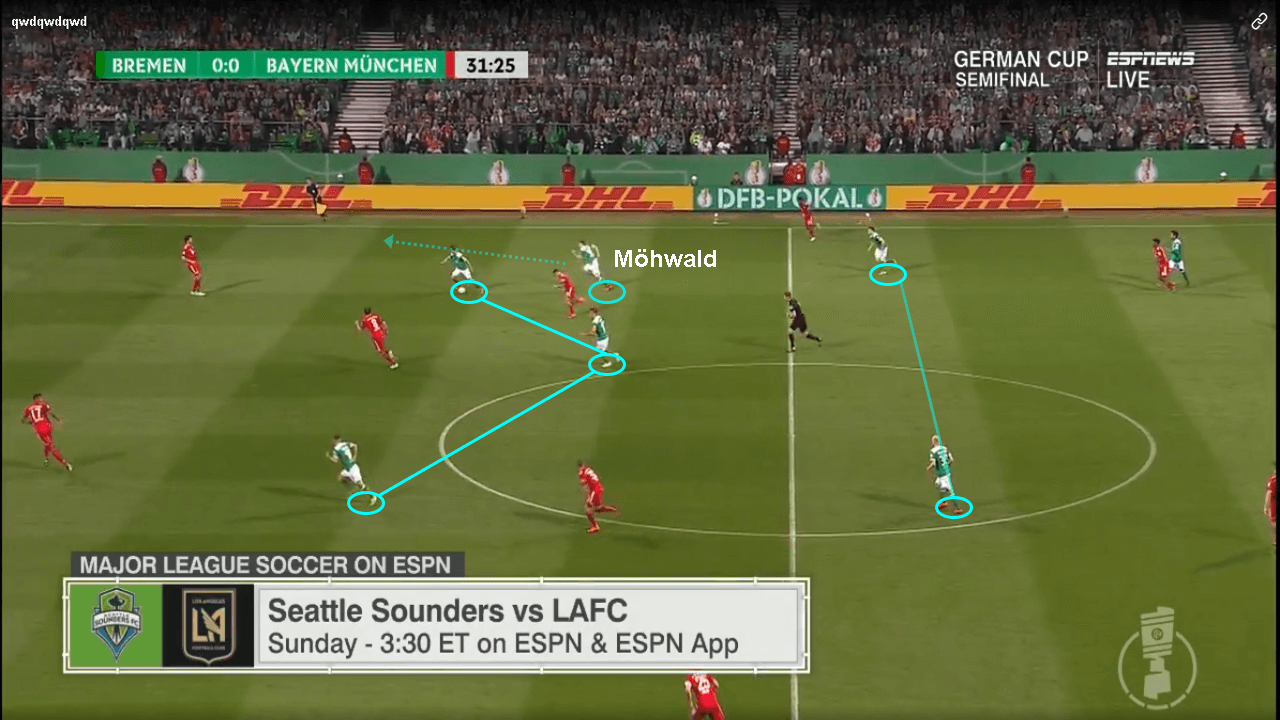

Bayern were able to rely on the quality and technical calibre of their full-backs to deal with Bremen’s pressing. Joshua Kimmich, a versatile right-back capable of playing as a central midfielder in the pivot role, tended to drift inside as his teammates were tightly marked. As the game progressed, we saw a gradual decline in short passing around the central areas and an increasing preference for crosses and long balls.
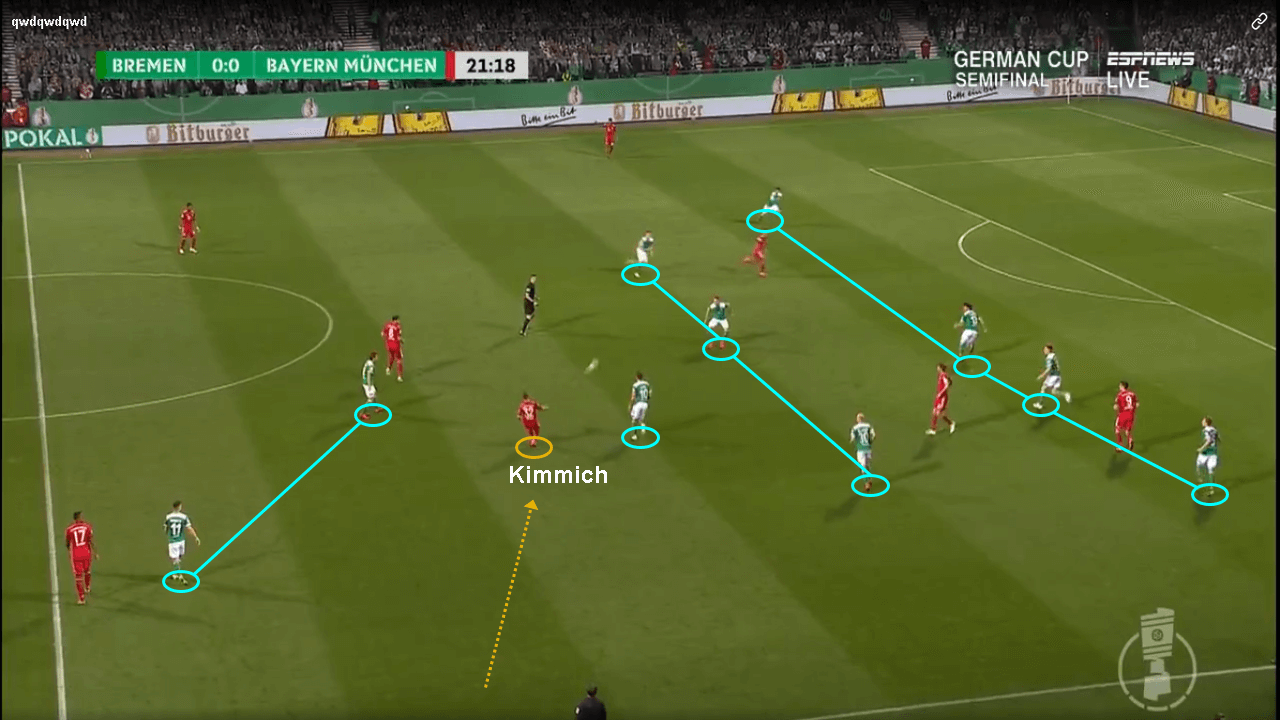
It takes a Müller and a post to draw first blood
Bremen were showing a remarkable work rate from the beginning to make up for the qualitative inferiority against Bayern’s heavy artillery. They were able to deal with Bayern’s counter-attacks effectively by chasing them down as a pack.
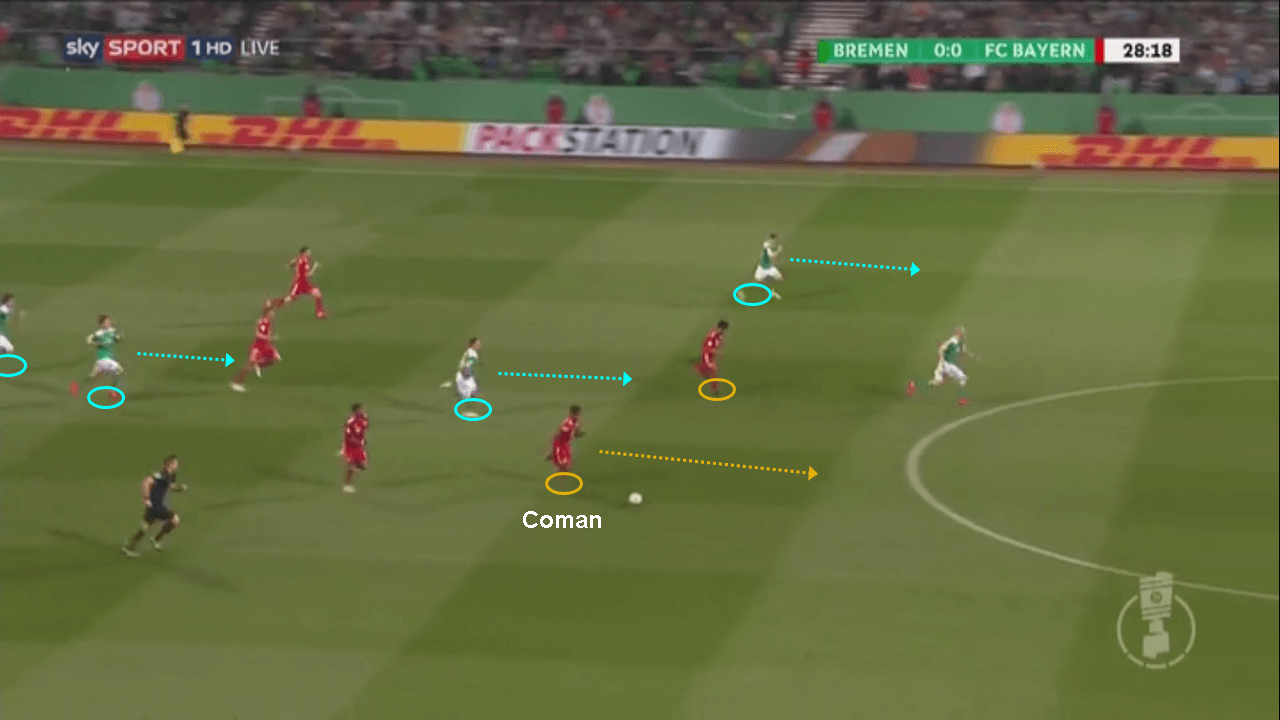
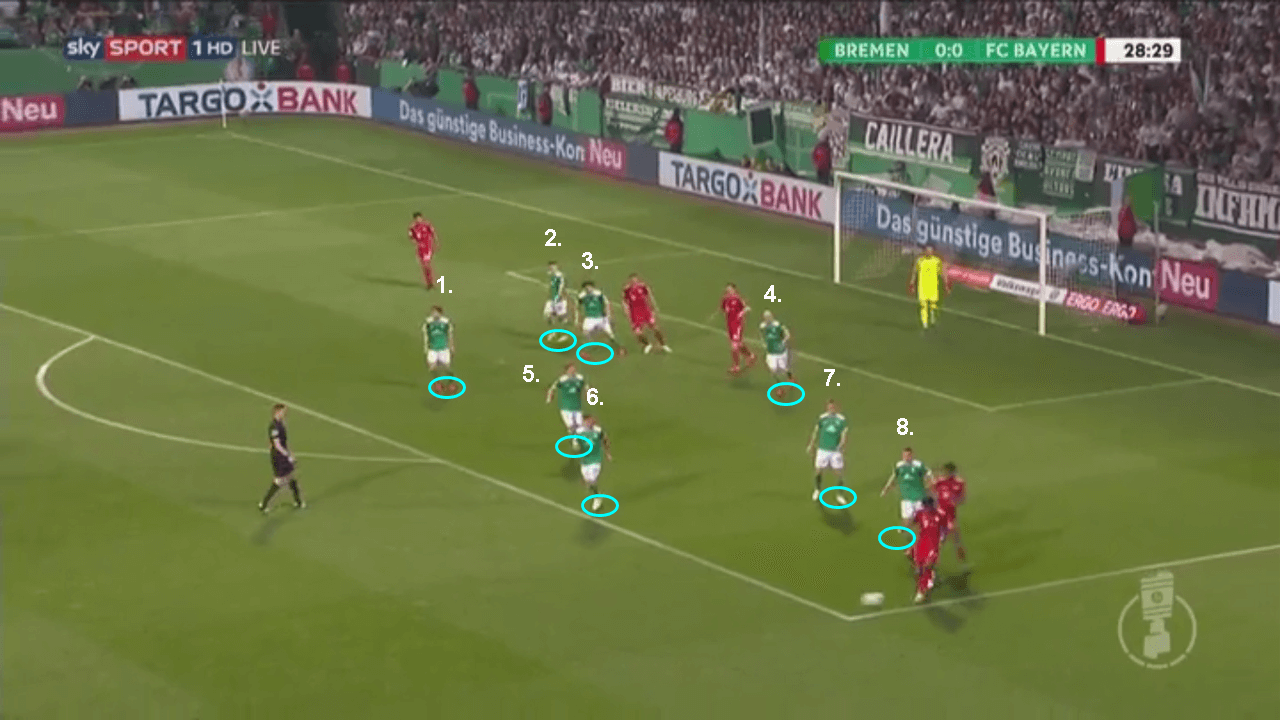
Bayern’s reliance on long balls and crosses saw their defenders drive forward into central areas and look to play lofted passes behind the Bremen defensive line. One such move from Boateng yielded fruit in the most unusual fashion. Miloš Veljković was caught in a dilemma of keeping the line high or following Müller’s run in behind.
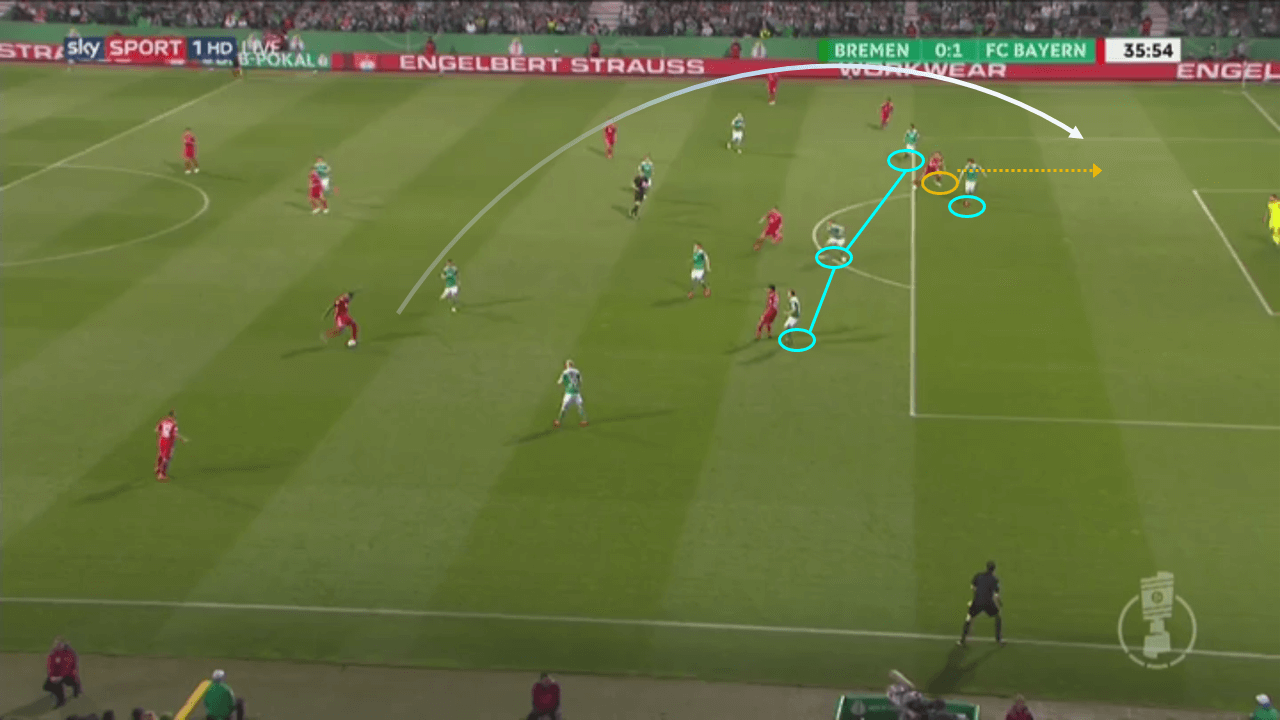
The cross landed well out of reach of both Veljković, and the keeper Jiri Pavlenka, but not Müller who managed to get a head on it towards the Bremen goal. The keeper and defender, Niklas Moisander, made in time to stop it from going in, but it freakily ricocheted off the post.
Moisander made a sliding attempt to defend Müller’s header but in doing so dragged Pavlenka along with him who couldn’t stop the post from assisting Robert Lewandowski. The most unusual of goals from a technical standpoint, but a very necessary one for Bayern as it put them in the driving seat.
Bayern play their cards well with a 1-0 lead
Being a goal up, the Bavarians were able to keep possession for longer and more effectively as Bremen was more vulnerable at the back when they attacked. For the rest of the first half, after Bayern’s goal and for the first 15 minutes of the second half, Bayern looked in total control of the game.
They were unable to finish a few clear chances with both Gnabry and Thiago looking a lot less threatening than usual. Gnabry found himself serendipitously loyal to his former club with a lackluster display for Bayern, forcing Kovač to bring in Goretzka just before the hour mark.
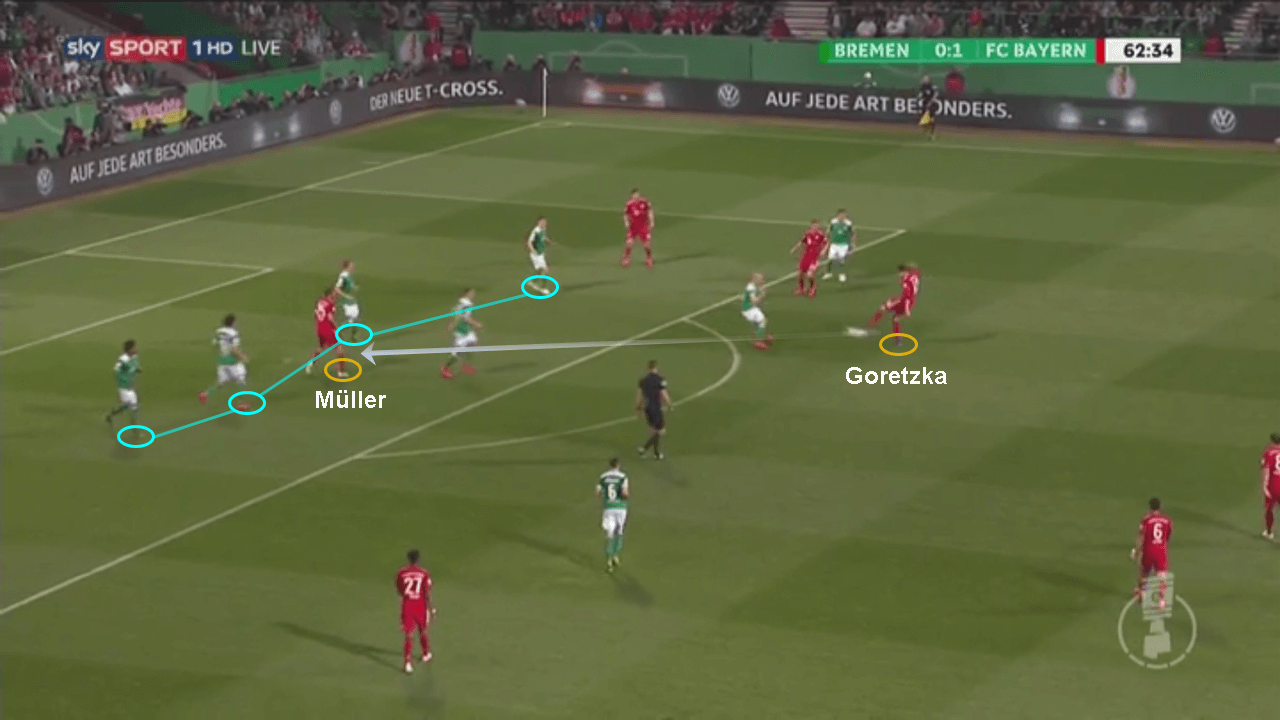
In the second half, Müller played higher up alongside former Dortmund striker Lewandowski putting pressure on the backline. A successful Bayern build-up saw the ball laid off to Goretzka. His attempted left-footed shot with the outside of the boot somehow managed to find Müller instead of the goal, who controlled and converted it almost mid-air in exquisite fashion. Just as the game looked out of Bremen’s reach, enter the 40-year-old Claudio Pizzaro.
Bremen’s fitting one-minute reply
With lesser risks to take at 2-0 down, Kohfeldt switched Bremen’s tactics to pure positional play. Pizarro, the veteran superhero for Bremen, got to work instantly playing as a proper striker. His much younger partner, Rashica, played closed to him in pursuit of second balls.
This freed up Osako who could now drift deeper into the half-spaces looking to receive the ball. Kruse did the same on the other half space. Klaassen stretched the play wide on the left wing while Gebre Selassie attacked down the right corridor. Bremen switched tactics so smoothly and effectively that Bayern took time to adapt.
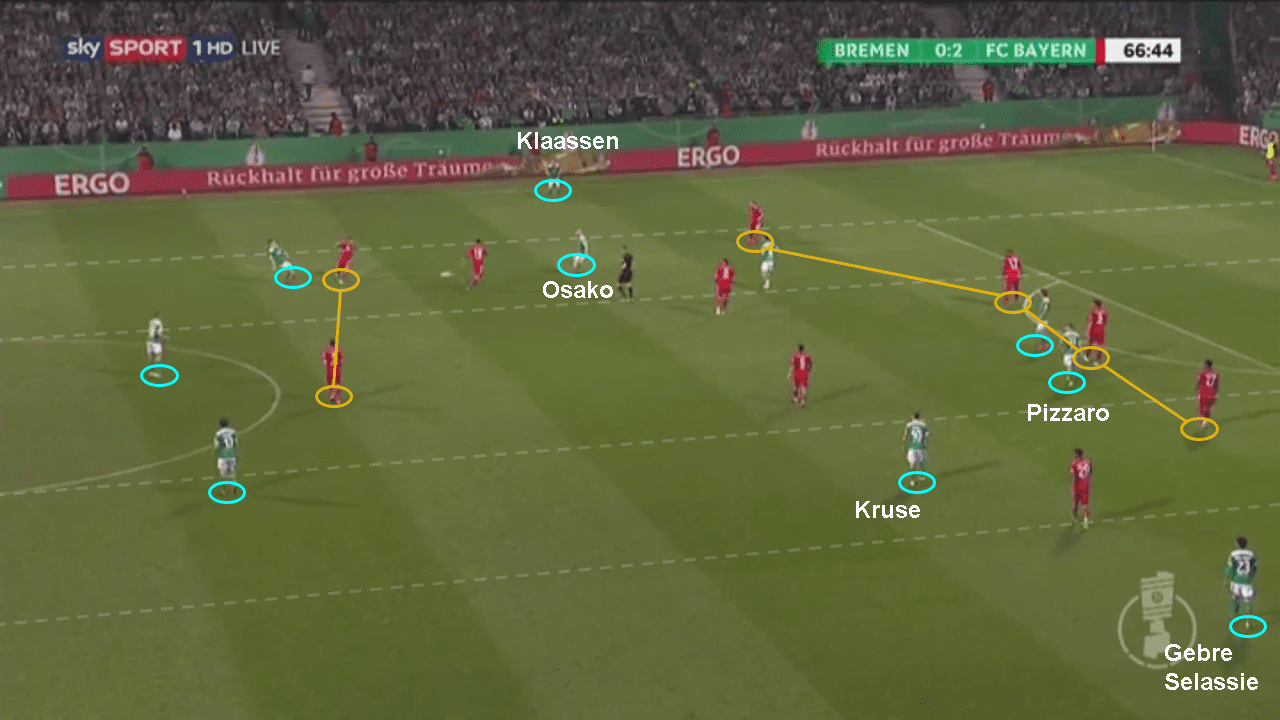
Moving the ball effectively around the 4-1-4-1 defensive Bayern block, they looked to create chances utilising superiorities behind defensive lines of pressure. Creating an overload on the left and a quick switch of play to the right, Osako found Gebre Selassie who put a cross in first time. It found Osako again in the penalty box and he converted it to make it 2-1.
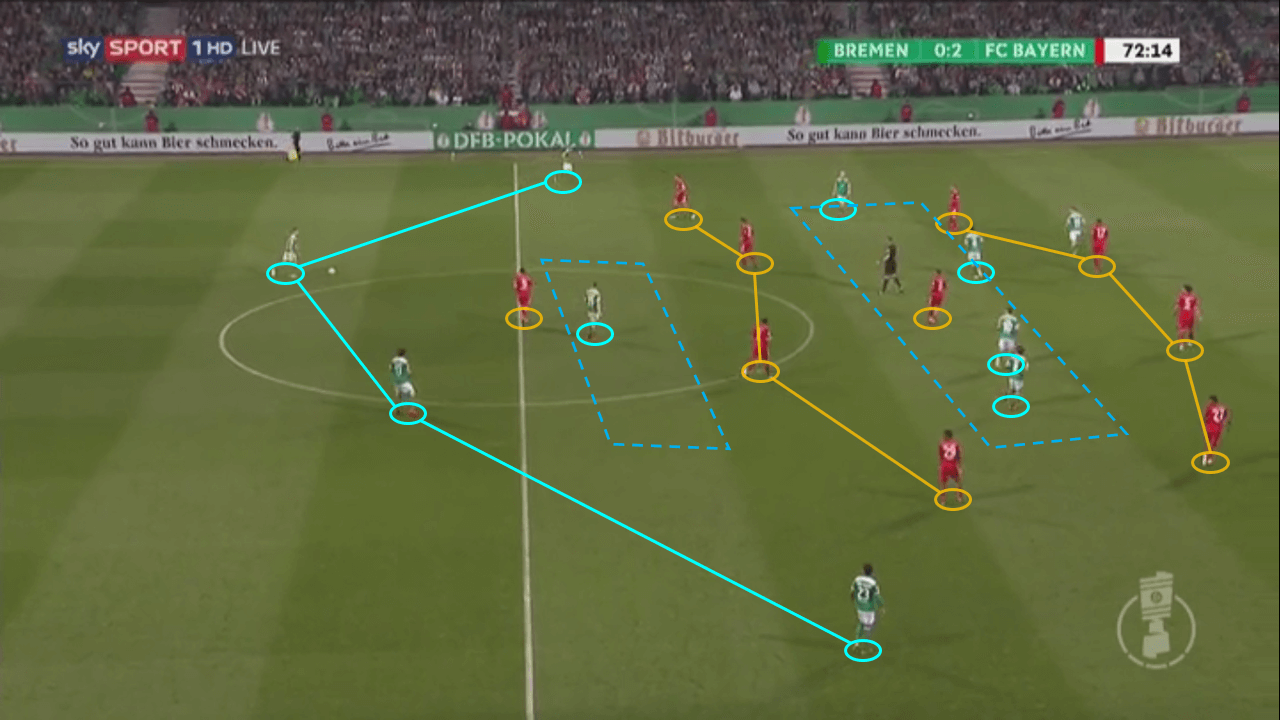
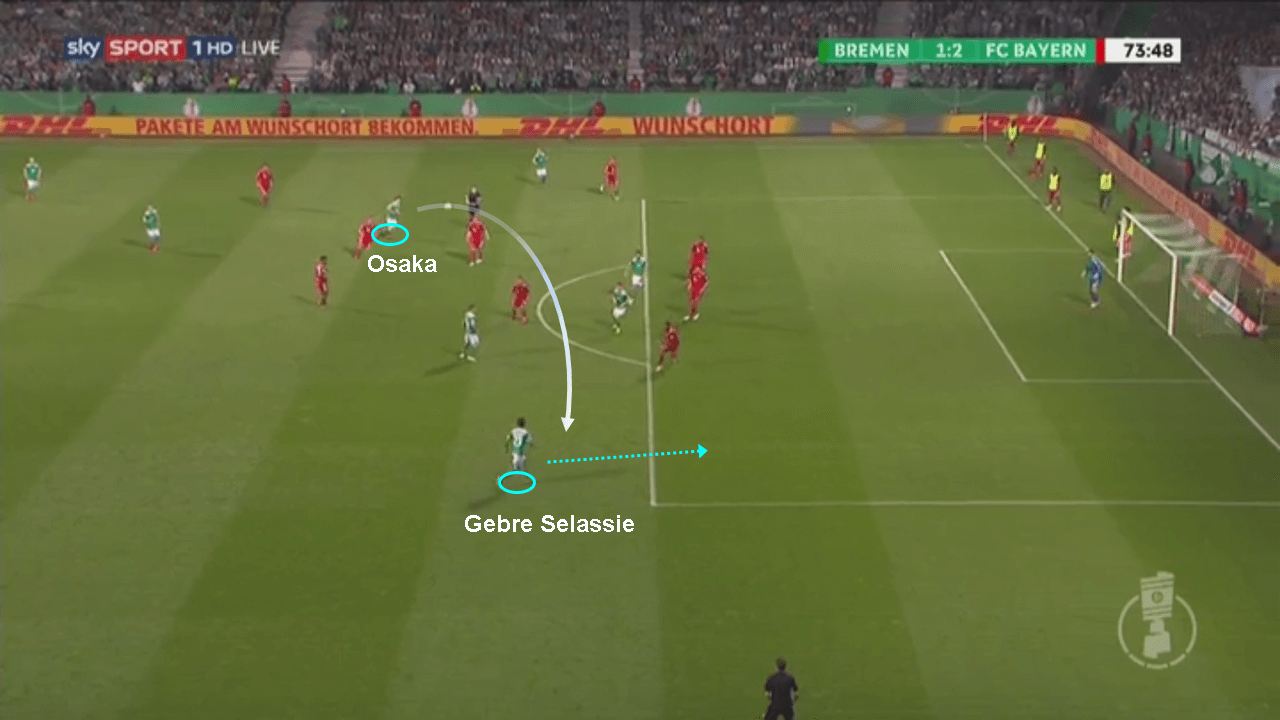
Right from the restart of play, Bremen pressed Bayern aggressively and won the ball immediately. An individual moment of brilliance from Rashica helped Bremen equalise the scoreline in under a minute. The atmosphere was nerve-wrecking.
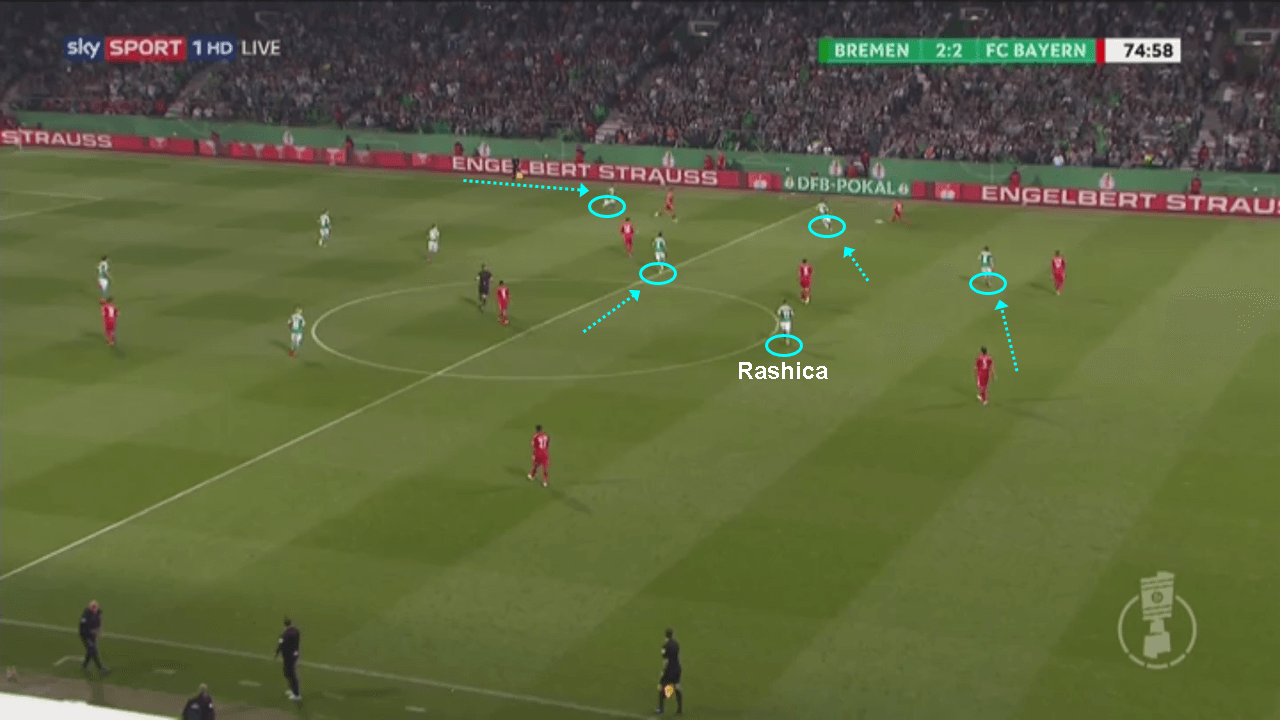
Birds of the same feather
With 15 minutes left and the game back on, Bayern were forced to give up their defensive tactics in search of the winner. Both teams effectively pressed each other while building up from the back forcing the long ball. Another striking similarity between them was the use of quick forwards to attack the space left behind by full-backs when they attacked higher up. With the game drawn at 2-2, both full-backs would inevitably need to attack higher.
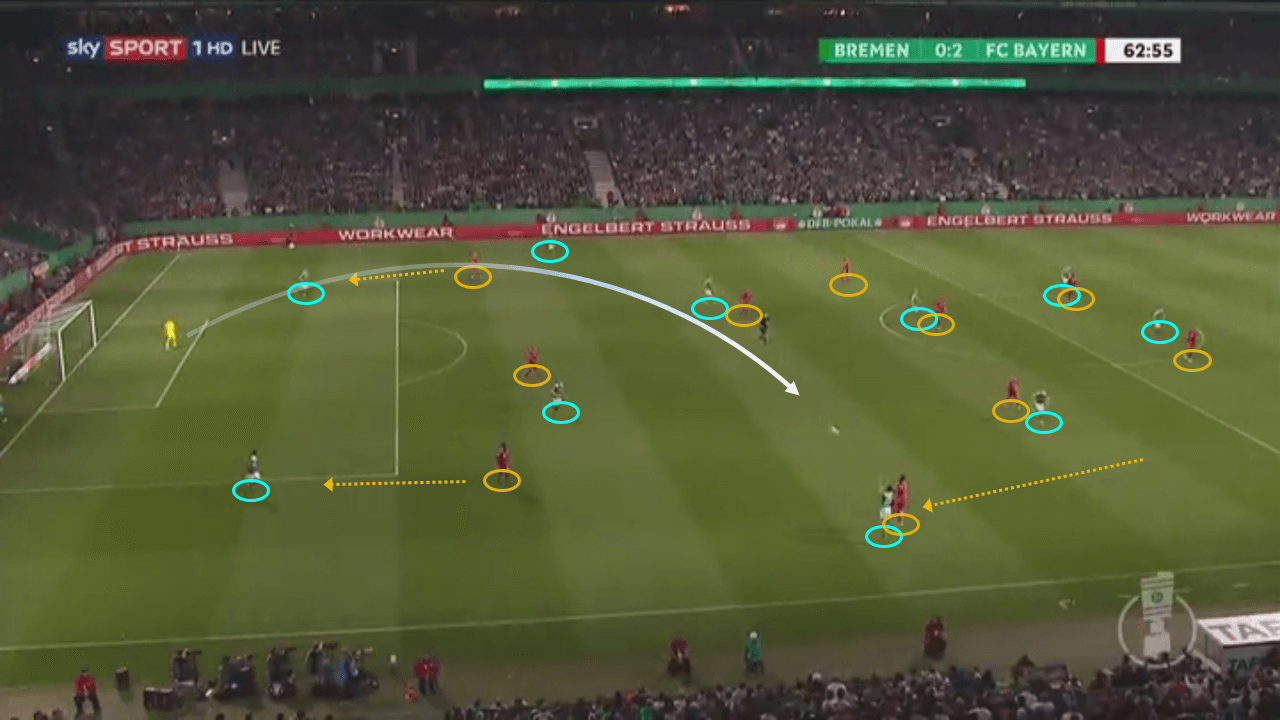
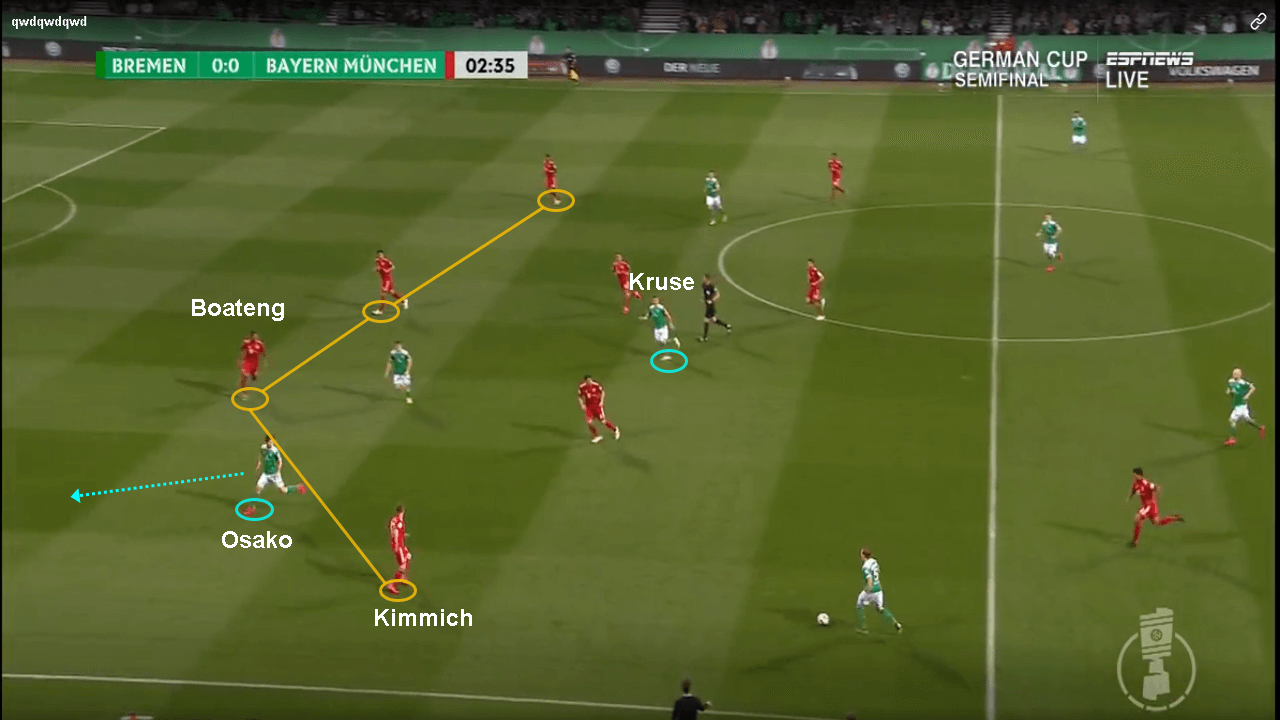
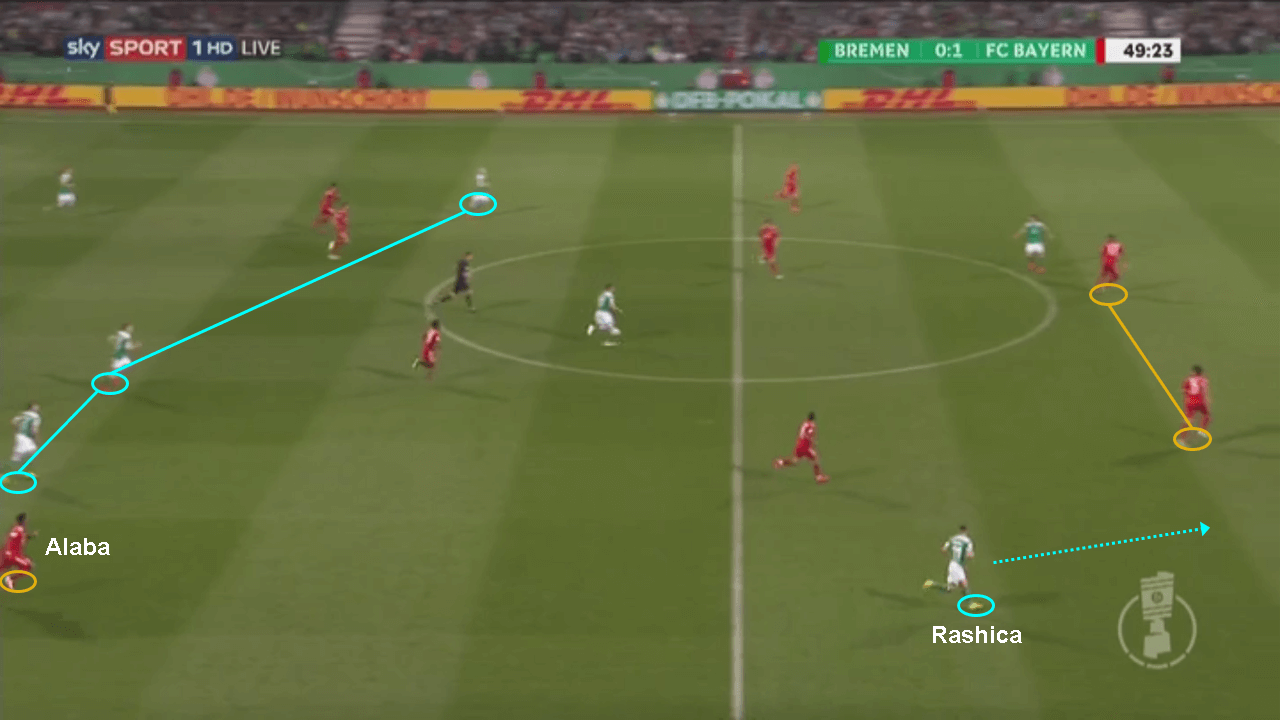
If it was Rashica who attacked the space left behind by Alaba, it was Coman who did the same against Gebre Selassie for Bayern. A specific moment found Coman able to beat Gebre Selassie at the edge of the 18-yard box.
A slight nudge by Gebre Selassie saw Bayern awarded a controversial penalty, even after review by VAR. With the fortunes tilted towards the Bavarians, Lewandowski managed to convert it again clinically giving Bayern Munich a ticket to the final. Could it have turned out any more dramatically?
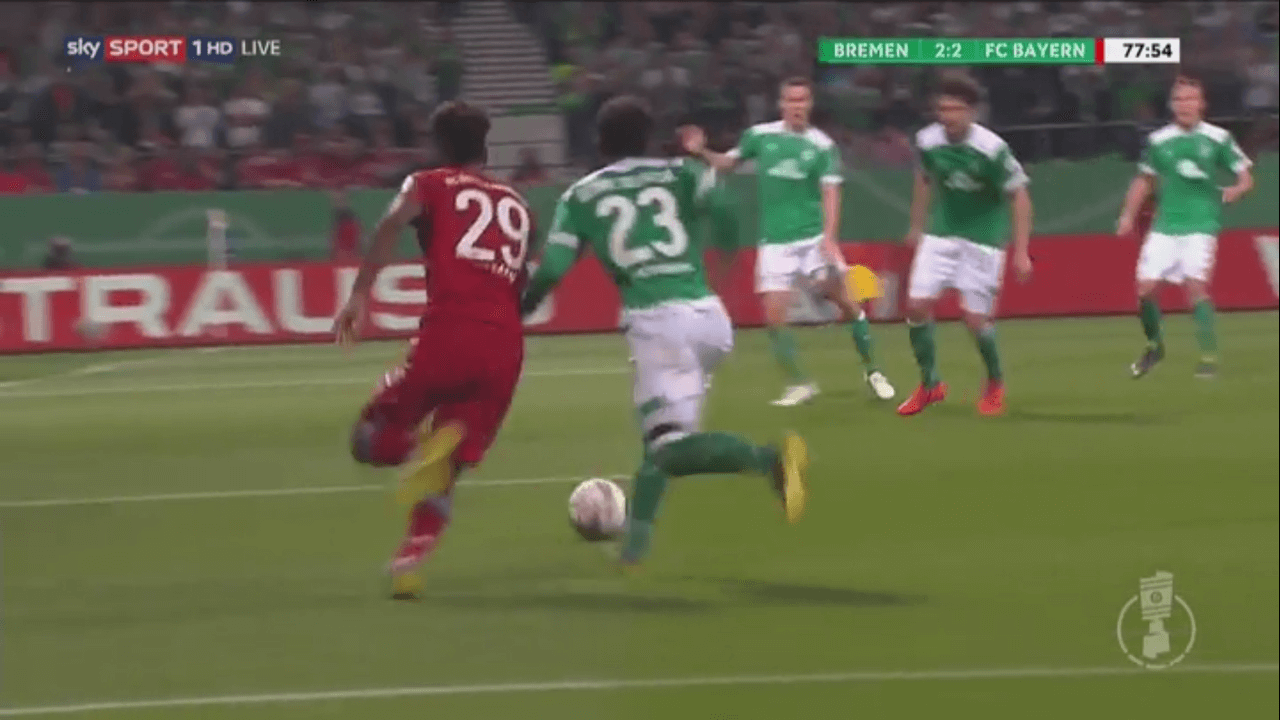
Conclusion
Thomas Müller justified his reputation as the one and only ‘Raumdeuter,’ or the space interpreter, who manages to find himself at the right place at the right time. He deserves due credit for Bayern’s win along with Lewandowski’s clinical finishing. Although Bayern were the more fortunate side, take nothing away from Nico Kovac’s effective switch of tactics to adapt to the tumultuous game environment and the desire of the Bavarians to reach the DFB Pokal final.
Florian Kohfelt proved once again that his Bremen side can put up an attractive show despite lacking the quality of players in comparison to bigger clubs. They can play both defensive or positional and attacking, depending on the scenario, and improvise their tactics like a chameleon. This Bremen side has a courageous heart, and it was evident yet again at the evergreen Weserstadion.
If you love tactical analysis, then you’ll love the digital magazines from totalfootballanalysis.com – a guaranteed 100+ pages of pure tactical analysis covering topics from the Premier League, Serie A, La Liga, Bundesliga and many, many more. Buy your copy of the April issue for just ₤4.99 here, or even better sign up for a ₤50 annual membership (12 monthly issues plus the annual review) right here.

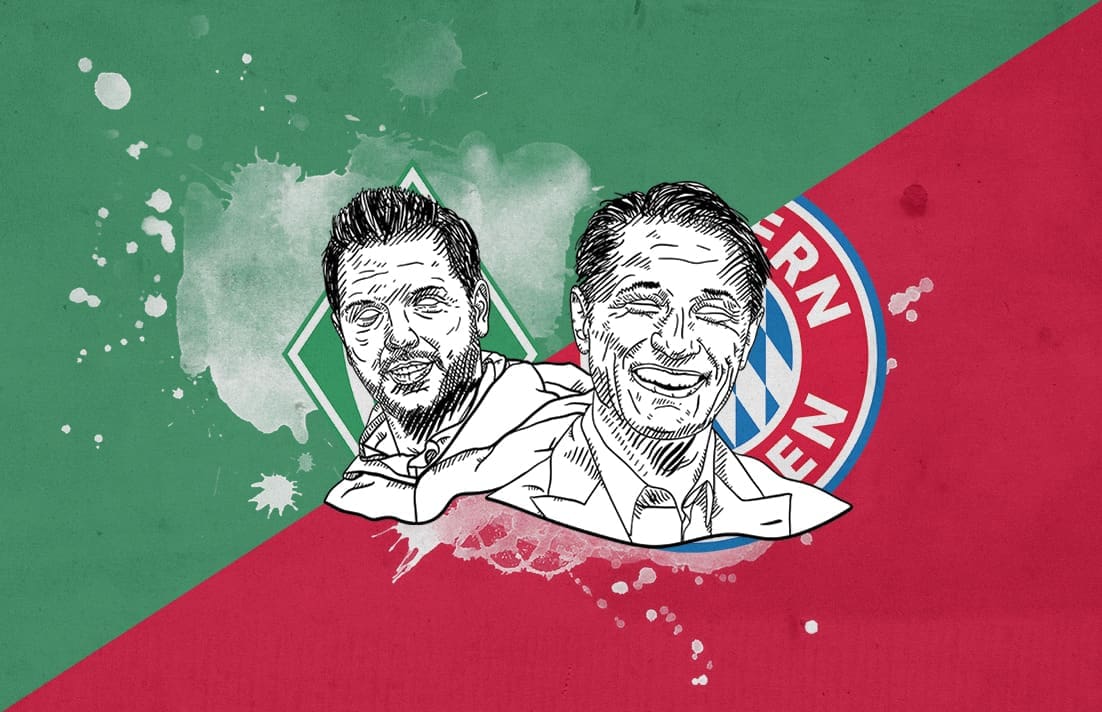


Comments